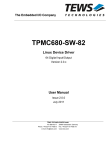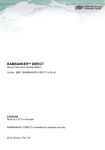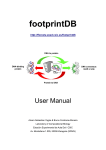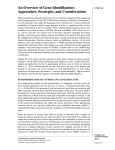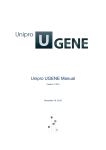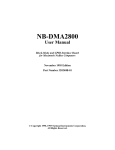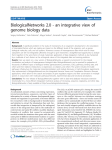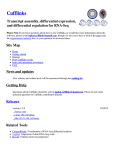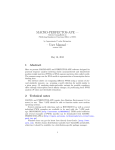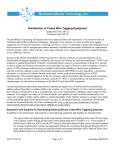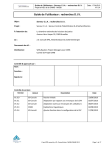Download Chapter 2
Transcript
Chapter 2 CORE TF: a User-Friendly Interface to Identify Evolutionary Conserved Transcription Factor Binding Sites in Sets of Co-Regulated Genes Matthew S. Hestand, Michiel van Galen, Michel P. Villerius, Gert-Jan B. van Ommen, Johan T. den Dunnen, Peter A.C. ’t Hoen The Center for Human and Clinical Genetics, Leiden University Medical Center, Postzone S4-0P, PO Box 9600, 2300 RC Leiden, The Netherlands. BMC Bioinformatics 2008, 9:495 Parts of this manuscript have been adapted to more appropriately fit this thesis. 19 2 CORE TF 2.1 Abstract Background: The identification of transcription factor binding sites is difficult since they are only a small number of nucleotides in size, resulting in large numbers of false positives and false negatives in current approaches. Computational methods to reduce false positives are to look for over-representation of transcription factor binding sites in a set of similarly regulated promoters or to look for conservation in orthologous promoter alignments. Results: We have developed a novel tool, ”CORE TF” (Conserved and Over-REpresented Transcription Factor binding sites) that identifies common transcription factor binding sites in promoters of co-regulated genes. To improve upon existing binding site predictions, the tool searches for position weight matrices from the TRANSFACR database that are over-represented in an experimental set compared to a random set of promoters and identifies cross-species conservation of the predicted transcription factor binding sites. The algorithm has been evaluated with expression and chromatinimmunoprecipitation on microarray data. We also implement and demonstrate the importance of matching the random set of promoters to the experimental promoters by GC content, which is a unique feature of our tool. Conclusion: The program CORE TF is accessible in a user friendly web interface at http://www.LGTC.nl/CORE TF. It provides a table of over-represented transcription factor binding sites in the users input genes’ promoters and a graphical view of evolutionary conserved transcription factor binding sites. In our test data sets it successfully predicts target transcription factors and their binding sites. 20 2.2 Background 2.2 Background There are both experimental and computational approaches to identify transcription factors (TFs) and their relevant binding sites. In the wet lab, hypothesis driven techniques, such as deletion constructs with luciferase reporter assays and chromatinimmunoprecipitation on microarrays (ChIP-on-chip), can be used to identify TF binding site (TFBS) regions. Luciferase assays can prove that a specific region has regulatory function, but they are laborious and time consuming. ChIP-on-chip is more global, but requires prior knowledge of which TF to target using a specific antibody and is laborious, time consuming, and expensive. Faster and cheaper in silico methods have been in development which can identify potential TFs and their binding sites. They also tend to target more precise the TFBS instead of just containing a TFBS region. However, finding TFBSs can be extremely difficult since they may be less than 12-14 bp long and their consensus binding sites may be fairly loose (49). One method to identify TFBSs for known TFs is using position weight matrices (PWMs) (50). PWMs summarize experimental information on the sequence preference of TFs. TRANSFAC (51; 52) is the leading PWM database for TFBSs with 834 matrices in total (release 11.4, December 2007), compared to 123 in JASPAR (53; 54). An additional method to look for new (de novo) TFBSs is by searching for conservation between orthologous promoters (58). This is based on the presumption that functional elements are evolutionary conserved since mutations to such elements could be detrimental to the organism (58; 59). However, both the sequence conservation-based and the PWM approach alone produce many false positives and false negatives. We therefore created CORE TF, a program using both methods to reduce false predictions. We first look for TFs involved in a biological process of interest, relying on the presumption that similarly expressed genes have common TFs as regulators. To do this, and reduce false predictions with PWMs, we search for TFBSs that occur more often in a co-regulated set of promoters compared to random promoters. This algorithm, in analogy to the work of Elkon et al, 2003 (57), implements a binomial test to evaluate for this over-representation. Some PWMs have a bias towards certain nucleotides, such as T’s and A’s for a TATA box binding TF and would therefore likely be over-represented if an experimental set had high numbers of T’s and A’s and the random set had equal content of all four nucleotides. We therefore also offer the option to exclude biases based on GC content by matching random promoters with approximately equal GC content to the experimental promoters. To identify individual TFBSs with increased precision, and add additional support for the relevant TFs, we subsequently scan individual promoters for cross-species conservation, again employing TRANSFAC matrices. All steps are flexible allowing for a multitude of input types (Ensembl (62) gene IDs, nucleotide sequences, or selected by CORE TF). We also compared CORE TF to two existing programs: oPOSSUM (60) and ConTra (61). CORE TF is accessible as a web-page. In this paper, we present and evaluate the performance of our web-based tool for identification of TFBSs. 21 2 CORE TF 2.3 2.3.1 Implementation CORE TF Construction Format The main script is written in Perl and presented in HTML on an Apache web-server. Input and table sorting is done using an edited Java script: sorttable.js (63). By default, following the title page, there are 6 pages that are run in a linear fashion feeding the results of one page into the next (Figure 2.1). Page one allows a user to select run options and input criteria, including a pvalue cut-off for highlighting data (see below), 6 different Match (the program that aligns TRANSFAC PWMs to nucleotide sequences) (51; 55) settings (minimize false positives, minimize false negatives, minimize the sum of both error rates, and nonredundant sets of these 3 settings), and data input type for a set of experimental promoters and a set of random promoters. The experimental promoter lists are entered as sequences in fasta format or Ensembl gene IDs. Five options are available for the random promoter list input: sequences in fasta format, an Ensembl gene ID list, randomly retrieve Ensembl promoters, pre-constructed promoter sets, and preretrieved sequence sets that are matched to the experimental set based on percentage of GC content. There is also an option to skip the over-representation analysis and go directly to page 4. Depending on the selections from page 1, page 2 presents text boxes to paste in lists of fasta format sequences or Ensembl gene IDs, or radio-buttons to select a certain number of random promoters for the appropriate species, or species based check boxes for pre-constructed runs or %GC matched runs. If CORE TF must retrieve promoters there are two options to define promoter sequences. The first option is to call a promoter as exon 1 plus a user defined number of base-pairs (bp) upstream. The second option is to define a promoter sequence as a user specified number of bp before and after the start of exon 1. The pre-constructed (approximately 3000 promoters) and pre-retrieved sets to match %GC on (approximately 10000 promoters, of which 3000 are selected) are based on 1000 bp upstream of exon 1 and exon 1 sequence. If requested, page 3 (Figure 2.2) uses Ensembl API to retrieve promoters from a locally installed Ensembl database or from the web-based Ensembl database depending on CORE TF installation. If the option to use %GC matched random sequences is selected CORE TF matches pre-retrieved promoter sequences to the experimental promoter sequences so that at least 3000 similar %GC promoters are obtained. It then uses Match to scan all sequences for the presence of TRANSFAC Professional (note: web based CORE TF is still free access to non-commercial users) vertebrate PWMs passing the PWMs’ alignment threshold provided on page 1 (pre-constructed random promoter sets also have pre-executed Match runs and initial number of hits counted). A binomial test is carried out with the Perl module Math::Cephes (64) to identify TFBSs that are over-represented in the experimental set over the random set. This is displayed on the screen as a sortable table with the TFBSs’ name, p-value (10 digits are displayed), hits and total number in the experimental and random sets, as well as the number of PWM hits in each experimental promoter. For clarity, pvalues below a defined threshold from page 1 are highlighted in blue. The table can be downloaded as an HTML file or a tab-delimited text file. The user can select a number of TFBSs plus a promoter of interest and continue to the next page. There is also a Java script with a button to automatically select all TFBSs with a p-value 22 2.3 Implementation Figure 2.1: Flowchart of CORE TF runs: CORE TF runs linearly through 6 web pages. Pages 1 and 2 take as input experimental gene/promoter lists and random gene/promoter lists or requests to create random lists. Depending on format, sequences are retrieved with Ensembl API or random lists generated before identifying TFBSs with Match/TRANSFAC. A binomial test is run to identify over-represented TFBSs in the experimental set compared to the random set and displayed in page 3 as a table. In the table TFs and a promoter can be selected which are sent to page 4. If requested homologs and sequences or genomic alignments are retrieved from Ensembl for the selected promoter. If not already a genomic alignment, input sequences or retrieved sequences are aligned with BLASTz. TFBSs are identified with Match/TRANSFAC, overlapping TFBSs are identified and scores calculated, and the data is displayed in page 5. Conserved TFBSs can be selected and displayed as highlights in the alignment in page 6. below the defined threshold. Page 4 gives the user the opportunity to use Ensembl defined orthologs or aligned 23 2 CORE TF Figure 2.2: Page 3 screen-shot: Page 3 of CORE TF displays the following columns: selection boxes for the next page’s analysis, all TFBS PWMs with hits, the p-value, the number of experimental promoters hit, the number of experimental promoters analyzed, the number of random promoters hit, the number of random promoters analyzed, frequency of hits in the random data, as well as a column for each experimental promoter analyzed indicating the number of TFBSs hit in it. Our page is lengthy, so for display purposes in this figure we deleted the middle TFBSs as indicated by the large black bar. For a full color figure see www.biomedcentral.com/14712105/9/495/figure/F2. genomic regions in a selection of species (currently H. sapiens, P. troglodytes, M. musculus, R. norvegicus, B. taurus, C. familiaris, and G. gallus) or enter user defined orthologous sequences in fasta format. There is also the option to define promoters as was done in page 2. If the user skipped over-representation analysis there is a list of TFBSs to chose from for analysis, otherwise CORE TF uses TFBS selection from page 3. This is given to page 5 which, if necessary, retrieves either orthologous IDs and sequences or aligned genomic regions with Ensembl API. Aligned genomic regions are pairwise alignments, but CORE TF places them into a multi-species viewed align24 2.3 Implementation ment. Sequences are again scanned by Match and TRANSFAC. If Ensembl genome alignments were not used, the first sequence entered or the ID used for orthologous retrieval is used as the reference to carry out a promoter sequence alignment with BLASTz (65). Alignments are displayed on the screen. Tables are shown with each TFBS selected and the following information: total score, region score, number of promoters aligned at that point, and the length of the TFBS. The region score is defined by taking the sum of 100 times the percent of each nucleotide aligned (Figure 2.3A). The total score is defined as the region score divided by the pattern length divided by 100 (Figure 2.3B). More specific details of these region numbers are displayed on additional tables lower in the page. The user may select a TF and submit this to the final page. Figure 2.3: Formulas for conservation scores. Page 6 (Figure 2.4) allows for visualization in the alignment by displaying the alignment with selected TFBSs highlighted according to the strand bound: blue (positive strand), purple (both strands), or red (negative strand). There is also evidence that some TFs may preferentially bind one strand over the other (5). It is up to the user to decide if their TF is strand specific or not. 2.3.2 CORE TF Evaluation with Expression and ChIP-on-chip Data To verify the performance of our algorithms we used expression and ChIP-on-chip data from Cao et al 2006 (66). They studied the promoter binding of two major regulators of muscle differentiation (MyoD and Myog) and expression profiles in embryonic fibroblasts from MyoD/Myf5 knockout mouse transduced with a MyoD-estrogen receptor hormone binding fusion protein (termed MDER cells). These cells have been modified so that they can be studied during differentiation with or without MyoD or 25 2 CORE TF Figure 2.4: Page 6 screen-shot of a conserved MyoD TFBS in the LAMA4 promoter: Page 6 of CORE TF displays two identical boxes containing aligned promoters with conserved TFBSs highlighted by color; blue if on the positive strand, purple if on both strands, and red if on the negative strand. For a full color figure see www.biomedcentral.com/1471-2105/9/495/figure/F4. If requested in the previous page to show run details (not shown in this figure), boxes with score construction for all conserved TFBSs are also displayed, as well as the patterns of all selected PWMs hit. Here we show an example of a MyoD TFBS (PWM MyoD Q6 01) in the LAMA4 promoter conserved in human, chimp, and dog on both strands. Myog present. Promoter binding was also studied in a common mouse myoblast cell line (C2C12). ChIP-on-chip is a technique using a TF targeting antibody that is used to pulldown TF bound DNA fragments, which are then amplified, labeled, and hybridized to a (promoter or tiling) microarray. As a positive control set for TF binding, we took those promoters from the ChIP-on-chip data that showed enrichment for MyoD or Myog binding sites (p-value < 0.001). We re-analyzed the Affymetrix expression data by applying a RMA summarization and normalization and using the R package limma (67; 68) to fit a linear model containing the following factors: MyoD expression (yes/no), Myog expression (yes/no), and time of differentiation (0, 24, 48, and 96 h). As a positive control set for MyoD or Myog-induced regulation of gene expression we took the top 200 or less genes based on the effect of MyoD or Myog expression, respectively. When needed, accession numbers were converted to Ensembl gene IDs using Idconverter (69). For the 200 most significantly induced genes, we evaluated whether their promoters contained MyoD or Myog TFBSs according to the ChIP-on-chip data. We expect that the smaller more specific lists would have a higher percent of promoters with true TFBSs (significant on the ChIP-on-chip platform) and therefore likely to contain more significantly over-representated TFBSs in our predictions. We found that as a general trend this is true that the smaller more specific expression lists contain a higher percent of true positives (significant ChIP-on-chip genes) (Additional File 2.1). 2.3.3 Random Data Size Evaluation We evaluated what would be an appropriate number of random promoters by running a set of 14 experimental promoters against several random set sizes; 500, 1000, 2000, and 4000. For this, the Match cutoff was set to minimize the sum of false positives and negatives. For this test we used a promoter size of 1000 bp before exon 1 and all of exon 1. The larger the random size used the more consistent the number of TFBSs 26 2.3 Implementation that were identified (Additional File 2.2), but also the longer the run time. We found a random size of 2000 promoters to be the best trade off between accuracy and speed. 2.3.4 Promoter Size Evaluation We evaluated an appropriate promoter size for our TFs of interest by taking the Cao et al. 2006 expression data top 50 MyoD- or Myog-responsive promoters for the appropriate stimulation (MyoD or Myog) compared to 2000 purely random mouse Ensembl promoters. We varied the promoter size to include exon 1 plus an additional number of bp upstream; 500, 1000, 2000, and 4000. Analysis showed that with a Match setting to minimize false positives a promoter size of 2000 bp + exon 1 was best, whereas with a Match setting to minimize the sum of false positives and negatives a promoter size of 1000 bp + exon 1 was preferable (Additional File 2.3). We continued with a Match setting to minimize the sum of false positives and negatives setting using 1000 bp upstream + exon 1 as our promoter size. 2.3.5 Evaluation of GC Content To evaluate the effect of GC content we ran purely random Ensembl promoters (the FAST setting of CORE TF) on all Cao et al ChIP data. We then compared that to runs with the option to get random promoters of approximately equal %GC content compared to the experimental set (the Similar %GC option). 2.3.6 Wet-lab Verification of a CORE TF Predicted Conserved TFBS To give wet-lab confirmation to the results of the CORE TF conservation predictions we used the TransFactor kit with double stranded DNA designed on a LAMA4 (ENSG00000112769) MyoD predicted TFBS conserved between human, chimp, and dog (Figure 2.4). This was an Ensembl genomic alignment run with a Match setting to minimize the sum of false positives and false negatives. The promoter size was defined as 3000 bp upstream of exon 1 and including exon 1. We also included a negative control of the same DNA sequence with four mutations. Recombinant MyoD protein was used to test for binding. For more details on the TransFactor run see the additional material (Additional File 2.4). 2.3.7 CORE TF Compared to an Existing Program: oPOSSUM To evaluate our script with existing technology we ran the Cao et al 2006 expression data (most significant 20, 50, 100, and 200 genes) through the oPOSSUM website (60). We chose oPOSSUM for comparison since it performs similar analysis and is freely available. We used their custom single site analysis page. Other than setting to mouse, vertebrate JASPAR PWMs, retrieving 1000 bp up and 433 bp downstream (using Ensembl API we calculated this as the average size of exon 1) of the transcription start site, and showing all results, all settings used their defaults. It must be noted that JASPAR only has a PWM for Myf, which represents a TF family including 27 2 CORE TF MyoD and Myog. We also used their number of hits in their background and target genes to run a binomial test in the statistical package R to match our data. 2.3.8 CORE TF Compared to an Existing Program: ConTra We also chose to evaluate CORE TF versus an additional easily viewable cross-species conservation program, ConTra (61). As a test promoter for comparison we used the LAMA4 (ENSG00000112769) promoter, for which we had a lab verified MyoD TFBS. The ConTra website was run on all default parameters (selecting transcript ENST00000230538), except for looking at 3000 bp upstream instead of 2000 bp upstream (giving a promoter the same size as the CORE TF run). We looked at the PWM MyoD Q6 01. This was the only PWM for MyoD available at the ConTra website and the best performing for CORE TF with this promoter. 2.4 2.4.1 Results and Discussion CORE TF Work Flow and Function We have developed a series of web pages to identify TFBSs in two sequential processes. First, pages 1 to 3 allow a user to predict TFs that regulate a set of co-regulated genes. This is done by identifying TFBSs that are over-represented in the promoters of an experimental (e.g. similar expressed genes from microarray data) compared to a random data set, taking GC content into account if requested. These results are displayed in a sortable table in page 3 (Figure 2.2). Secondly, pages 4 to 6 allow a user to identify specific TFBSs by looking for across species conservation of TFBSs selected from the TFBSs in page 3 and the promoters of page 3. This is done on Ensembl genomic alignments or BLASTz alignments of orthologous promoters provided by Ensembl or the user. Across species conserved TFBSs are displayed in tables (calculations as in Figure 2.3) in page 5 and as aligned promoters in a graphical format (Figure 2.4) in page 6. Alternatively, if a user did not wish to look at a list of promoters, but just a single promoter they could look purely for cross-species conserved TFBSs by skipping straight to page 4 from page 1. They must then provide which promoter they want to search and a set of TFBSs from a web displayed list. In theory they could paste the sequences conserved in the alignments back into the over-representation pages to find TFBSs over-represented in conserved regions (as opposed to the normal order of looking for conservation with over-represented TFBSs). 2.4.2 Prediction of Over-Represented TFBSs To evaluate the performance of our tool we first used the Cao et al 2006 ChIP-on-chip data as a positive control. We tested whether the promoters in the ChIP pull-down were enriched for the TFBSs for the TFs targeted in the ChIP experiments compared to a random set of promoters. To evaluate the effect of matching promoters for %GC content, CORE TF was run with a purely random selected set of promoters (FAST option) and a random set of promoters with matched %GC content as controls (similar %GC option). Using both sets of random promoters, CORE TF found a significant 28 2.4 Results and Discussion over-representation (p-value < 0.05, after applying multiple test correction with Benjamini Hochberg in R (70)) for the MyoD PWM MYOD Q6 in the MyoD bound promoters and the Myog PWM MYOGENIN Q6 in the Myog bound promoters, in both C2C12 and MDER cells (Additional File 2.5). The MyoD PWM MYOD Q6 01 was also significant in all MyoD targeted runs except the MDER MyoD with random promoters matched on %GC content. Strikingly, by ranking TFBSs on p-value, we demonstrate that the target TFs were higher ranked with the %GC matched promoters as control rather than with the purely random set of control promoters (Table 2.1), indicating that improper matching of GC content leads to false positive identification of TFBSs. By evaluating the distribution of p-values for all TFs using both random sets, we observed purely random promoters yield more high and low p-values than a random set of promoters matched on %GC content (Additional File 2.6). Since our target ChIP TFs remained significant when using %GC matched promoters, resulting in a smaller list of significant TFBSs, we believe this method to yield less false positives. To demonstrate that our algorithm is able to find shared regulatory sites in coregulated genes identified in expression microarray data we evaluated whether genes for which the expression level increased upon MyoD or Myog activation were enriched for MyoD or Myog TFBSs. We ran sets consisting of the 20, 50, 100, and 200 genes most significantly affected by MyoD or Myog activation versus a random set of approximately equal %GC content (Additional File 2.7). We found significant enrichment of the MyoD Q6 PWM in all MyoD enriched sets. We also found MYOD Q6 01 enriched in the top 50 and top 100 MyoD enriched sets. MYOGENIN Q6 was found enriched in the top 20 Myog enriched set only. Other PWMs for MyoD or Myog and other sets of promoters were not significant or considered ”NA” due to 100% of promoters hit in the experimental data. The same data was also run through with the CORE TF FAST setting. We found that the two settings perform similar, with slightly higher frequencies but slightly less significant p-values when matching on %GC (Figure 2.5). Additionally, as expected the smaller more specific lists generally have higher frequencies and lower p-values than larger, less specific lists (Figure 2.5). 29 30 C2C12 MyoD %GC MYOGENIN Q6 AP4 Q5 E2A Q2 AP4 Q6 MYOD Q6 AP4 Q6 01 E47 01 E12 Q6 LBP1 Q6 E2A Q6 SMAD Q6 01 MYOD Q6 01 AP1FJ Q2 AP1 Q4 E47 02 C2C12 Myog %GC AP4 Q5 AP4 Q6 MYOGENIN Q6 MYOD Q6 AP4 Q6 01 E2A Q2 AREB6 01 MYOD Q6 01 LBP1 Q6 AP4 01 AP1 Q4 ZEC 01 E2A Q6 ATF6 01 E47 01 p-val* 0 0 0 0 0 0 0 0 0 0 7.9E-09 7.9E-09 2.2E-08 5.8E-08 6.2E-08 p-val* 0 0 0 0 0 0 0 0 0 4.7E-09 1.6E-07 2.3E-07 1.3E-06 6.5E-06 7.5E-06 p-val* 0 0 0 5.0E-06 1.1E-05 9.0E-04 6.9E-03 1.4E-02 1.4E-02 1.9E-02 2.2E-02 2.2E-02 7.1E-02 8.0E-02 8.2E-02 p-val* 1.5E-06 2.3E-06 2.7E-06 8.8E-06 8.8E-06 5.1E-05 1.1E-03 1.4E-03 4.0E-03 4.6E-03 2.7E-02 4.4E-02 4.5E-02 5.8E-02 9.4E-02 MDER Myog FAST AP1 Q6 01 AP4 Q5 AP4 Q6 COUP DR1 Q6 E2F1DP1 01 E2F4DP2 01 E2F Q4 E2F Q6 01 LBP1 Q6 MAF Q6 01 MYOGENIN Q6 NF1 Q6 01 NFE2 01 OSF2 Q6 AP4 Q6 01 MDER MyoD FAST AP1 Q6 01 AP4 Q5 COUP DR1 Q6 E2F1DP1 01 E2F4DP2 01 E2F Q4 E2F Q6 01 MAF Q6 01 NF1 Q6 01 NFE2 01 NFKB Q6 OSF2 Q6 AP4 Q6 GATA3 01 LBP1 Q6 p-val* 0 0 0 0 0 0 0 0 0 0 0 0 0 0 6.4E-09 p-val* 0 0 0 0 0 0 0 0 0 0 0 0 3.5E-09 3.5E-09 6.5E-08 MDER Myog %GC AP4 Q5 AP4 Q6 MYOGENIN Q6 AP4 Q6 01 LBP1 Q6 MYOD Q6 E2A Q2 MYOD Q6 01 CLOCKBMAL Q6 AP2ALPHA 01 ZEC 01 AP2 Q6 AP4 01 PPARG 01 CMYC 02 MDER MyoD %GC AP4 Q5 AP4 Q6 MYOGENIN Q6 AP4 Q6 01 AP4 01 MYOD Q6 E2A Q2 LBP1 Q6 HEN1 02 TAL1BETAE47 01 MYOD Q6 01 HEB Q6 HELIOSA 01 AP1 Q4 HNF4 01 Table 2.1: Cao et al 2006 top ChIP-on-chip predictions with CORE TF p-val* 0 0 0 2.5E-06 8.0E-06 8.1E-06 7.1E-03 8.6E-03 4.5E-02 5.7E-02 5.8E-02 7.7E-02 1.1E-01 1.2E-01 1.2E-01 p-val* 0 3.1E-06 2.7E-05 2.7E-04 1.2E-03 4.5E-03 5.2E-03 2.3E-02 7.6E-02 7.6E-02 1.7E-01 2.9E-01 2.9E-01 4.0E-01 4.0E-01 CORE TF predictions on Cao et al 2006 ChIP-on-chip data. Target TFBSs are presented in bold. * = p-values are Benjamini Hochberg corrected. Note: in the MyoD FAST runs MYOD Q6 and MYOD Q6 01 had p-values < 0.05 but were not in the top 15 significant TFBSs. C2C12 MyoD FAST AP1 Q6 01 E2F1DP1 01 E2F4DP2 01 E2F Q4 E2F Q6 01 GATA3 01 MAF Q6 01 NF1 Q6 01 NFE2 01 OSF2 Q6 AP4 Q5 MYOGENIN Q6 LBP1 Q6 AP4 Q6 AP4 Q6 01 B.Myog ChIP-on-chip C2C12 Myog FAST AP1 Q6 01 AP4 Q5 AP4 Q6 E2F1DP1 01 MAF Q6 01 MYOGENIN Q6 NF1 Q6 01 NFE2 01 OSF2 Q6 E2F4DP2 01 COUP DR1 Q6 AP4 Q6 01 E2F Q4 GATA3 01 MYOD Q6 A. MyoD ChIP-on-chip 2 CORE TF 2.4 Results and Discussion Figure 2.5: Significance of myogenic TFBSs in expression data: The (A) significance (as the absolute value of the log10 p-value) and (B) frequency of MyoD (PWM MyoD Q6) or Myog (PWM MYOGENIN Q6) TFBSs in varying number of promoters from genes with increasingly less significant differences in expression upon MyoD or Myog activation are shown. As would be expected, the smaller more significant lists generally have higher frequency and more significant p-values than larger less specific lists. 2.4.3 Orthologous Alignments Versus Genomic Alignments In many CORE TF runs we assessed the conserved TFBSs using alignments based on homologous Ensembl promoters as well as Ensembl genomic alignments. Ensembl pairwise alignments can be considered syntenic (they are grouped to make the actual Ensembl synteny blocks) (71). Ensembl orthologs are identified using protein tree calculations (62). The number of promoters aligning and the quality of the alignment to the reference promoter varies tremendously amongst different promoters for both methods (data not shown), but we did not find one method outperforming the other. Synteny does not imply the start of one gene corresponds to the start of a gene in another species. Therefore, this could give poor predictions for TFs that bind and function close to the transcription start site. However, due to many incorrect exon 1 annotations it is also possible that using orthologous promoter alignments may align regions that are not corresponding regions (if an annotation missed exon 1, exon 2 would be annotated as exon 1 and we would instead align to it). Therefore there is not one alignment method that outperforms another to predict conserved TFBSs. 2.4.4 TFBSs Conserved in Orthologous Alignments The top 10 ranked genes of the Myog-induced genes were inspected for the presence of MYOGENIN Q6 motifs. To this end, all available orthologs for the mouse genes were retrieved. All conserved TFBSs and their conservation scores are reported in Table 2.2. There are seven promoters which appear to have conserved TFBSs. Four of these promoters (Chrng, Myog, Acta1, and Tnnc1 ) had hits in three or more orthologs. We also inspected the MyoD induced genes presence of MyoD 01 motifs using the same approach and identified two promoters with conserved TFBSs (Table 2.2). Only one promoter was found conserved over three or more orthologs (Rgs16 ). In addition, of the nine across species conserved TFBSs all except Tnnc1 (not on the array), Tnnc2, 31 2 CORE TF Rgs16, and Nptx1 were found significant in the ChIP-on-chip data. Literature was examined to see if predictions were correct. We found evidence for binding of Myog to Myog (72), Tnni1 (73), and Chrng (74). We also found evidence for MyoD binding Nptx1, also called NP1 (75). Table 2.2: Orthologous conservation of target TFBSs in target genes A Tot. Score #Promos Length Gene GeneID TF Name Name Score 1 1000 5 10 Chrng ENSMUSG00000026253 MYOGENIN Q6 1 1000 5 10 Chrng ENSMUSG00000026253 MYOGENIN Q6 1 1000 2 10 Tnnt3 ENSMUSG00000061723 MYOGENIN Q6 1 800 2 8 Tnnc2 ENSMUSG00000017300 MYOGENIN Q6 1 800 2 8 Tnni1 ENSMUSG00000026418 MYOGENIN Q6 5 8 Myog ENSMUSG00000026459 MYOGENIN Q6 0.83 666.7 4 8 Acta1 ENSMUSG00000031972 MYOGENIN Q6 0.8 640 4 10 Tnnc1 ENSMUSG00000021909 MYOGENIN Q6 0.72 720 3 8 Acta1 ENSMUSG00000031972 MYOGENIN Q6 0.6 480 B Tot. Score #Promos Length Gene GeneID TF Name Name Score 1 1200 4 12 Rgs16 ENSMUSG00000026475 MYOD 01 0.5 600 2 12 Rgs16 ENSMUSG00000026475 MYOD 01 0.4 840 2 21 Nptx1 ENSMUSG00000025582 MYOD 01 0.4 480 2 12 Nptx1 ENSMUSG00000025582 MYOD 01 Conserved TFBSs for (A) Myog (PWM MYOGENIN Q6) and (B) MyoD (PWM MYOD 01) from target genes’ promoters in expression data. Total score represents a score of conservation from 0 to 1 over the conserved TFBS length. Score represents an additive score over the TFBS. Promos is the number of promoters with the conserved TFBS. Length is the length of the TFBS. 2.4.5 Wet-lab Confirmation of a CORE TF Predicted Conserved TFBS To confirm a CORE TF conserved TFBS in the lab we looked at a MyoD predicted TFBS in the LAMA4 promoter. Using Ensembl defined genomic alignments we found the matrix MyoD Q6 01 conserved in human, chimp, and dog (Figure 2.4). Using a recombinant MyoD protein and the TransFactor kit we found significant (p-value 1.5E-35) binding to our target TFBS compared to a mutated one (Additional File 2.4). 2.4.6 CORE TF Compared to Existing Programs: oPOSSUM We compared the performance of CORE TF (using a random set with similar %GC) to oPOSSUM, a webtool with similar objectives as ours. oPOSSUM looks for overrepresented JASPAR PWMs in pre-defined species alignments, but is limited to spe32 2.4 Results and Discussion cific species alignments (e.g. human-mouse) and use of the smaller JASPAR PWM database. We used the previously mentioned expression microarray datasets for the evaluation of both programs performances. Our runs on the oPOSSUM website showed that our binomial test performs similar to their Fisher test (Additional File 2.8). Unlike our frequency observations, the frequency identified by oPOSSUM of TFBS hits in the MyoD induced set did not show the expected high to low pattern (Additional File 2.9). When comparing p-values from the binomial tests for the predictions by the two programs, we see similar patterns between the two programs across the top 20, 50, 100, and 200 genes, but CORE TF has more significant MyoD predictions and oPOSSUM has more significant Myog predictions (Additional File 2.9). It must be noted that we are only comparing over-represented TFBSs whereas oPOSSUM has already taken conservation into their program at this point which may explain higher sensitivity for Myog promoters. We instead do this on individual promoters and display it graphically in the next step. We believe this graphical representation to be more interpretable. Since we can do better in one out of two tested TFs without our orthologous promoter conservation we believe CORE TF to be a superior tool. The two programs differ on several other levels. oPOSSUM only takes Ensembl IDs as input, whereas we also accept nucleotide sequences. We also offer a larger choice of random data sets and conservation methods, as well as the choice to account for GC content. In addition, our number of vertebrate species available is six, all of which can be compared together. oPOSSUM only accepts two species comparisons at a time. For vertebrates oPOSSUM is limited to only human and mouse, both of which are in CORE TF. In addition, we display our across-species TFBSs in a graphical format, whereas oPOSSUM presents their data in a less intuitive tabular format. 2.4.7 CORE TF Compared to an Existing Program: ConTra We also evaluated CORE TF versus ConTra using the LAMA4 promoter, for which we had experimental data available, as an example. ConTra is a website to identify and easily view conserved TFBSs in a single cross-species promoter alignment, but cannot look for over-representation in a large promoter set. We found that in CORE TF genomic alignment predictions there were three MyoD TFBSs conserved between human and chimp and one TFBS conserved between human, chimp, and dog (Figure 2.4). ConTra found the same TFBSs, but also three additional (Additional File 2.10 and data not shown). Two of the three human/chimp CORE TF conserved TFBSs and the human/chimp/dog CORE TF conserved TFBS were also found conserved in the macaque in ConTra. CORE TF did not search for macaque, but it is extremely similar to human and chimp so we believe it would not add much information. However, if a user wanted any Ensembl species added to CORE TF adding an additional species to the scripts is very simple. It is not surprising the same TFBSs were identified since both programs use Ensembl alignments and TRANSFAC PWMs. ConTra does have the disadvantage of only using human as a reference genome for automated alignment retrievals, whereas CORE TF can do this for all six species currently installed. Additionally, CORE TF does not use an Ensembl multi-species defined alignment, but combines many Ensembl pair-wise alignments into one, allowing any number of Ensembl species to be included in one alignment. ConTra does not 33 2 CORE TF display strand specific binding which CORE TF does by color coding. Additionally, ConTra does not search for over-represented TFBSs in a group of promoters. 2.4.8 Future Efforts An item that can be improved in the future is our evolutionary scoring algorithm, e.g. by taking into account the confidence of each nucleotide in the PWM. An additional improvement will be to analyze combinations of TFBSs. 2.5 Conclusion We have developed a tool for identifying over-represented TFBSs in promoters from co-expressed genes aided by the evaluation of cross-species conservation. CORE TF is easy to use and displays results in tables or graphically allowing for easy interpretation of the results. Our method seems to correctly predict the presence of experimentally verified TFBSs, as shown by our extensive analysis on Cao et al. 2006 expression and ChIP-on-chip data and wet-lab confirmation of a MyoD predicted TFBS in the LAMA4 promoter. We also show improvements over two existing programs (oPOSSUM and ConTra) with greater flexibility in input data, coverage of a larger number of species, more intuitive output, and the option to account for GC content. Our tool is provided as a web service free to all non-commercial users. 2.6 Availability and Requirements Project name: CORE TF Project home page: http://www.LGTC.nl/CORE TF Operating system(s): Linux Programming language: Perl (we used 5.8.4) Other requirements: TransFac Professional (we used 11.2), BLASTz, sorttable.js, Math::Cephes (Perl module), Apache (we used 1.3.33) License: GNU General Public License, v3 http://www.gnu.org/licenses/ Any restrictions to use by non-academics: none for website use, TransFac Professional license for a local install 2.7 Authors’ contributions MH, JD, GO, and PH conceived of the primary concepts of the software. MH and MG did the primary programming and debugging. MV performed all primary installations on the web-server and helped in debugging code. MH, MG, and PH performed the software evaluation on expression and ChIP-on-chip data. Wet-lab work was done by MH. Manuscript drafting was done by MH, MG, JD, GO, and PH. All authors read and approved the final manuscript. 34 2.8 Acknowledgements 2.8 Acknowledgements We would like to thank Renee de Menezes and Maarten van Iterson for their statistical comments and Ivo Fokkema for his programming and implementation assistance. This work was funded by the Center for Biomedical Genetics (in the Netherlands). PH was supported by a VENI-grant from the Dutch Organization for Scientific Research (NWO grant 2005/03808/ALW). 35 2 CORE TF 2.9 Additional Files Additional File 2.1 Overlap of most significant expression genes in ChIP-on-chip data. Indicated are the size of the lists for the top expressed genes and the percent of those contained in the significant ChIP-on-chip genes (true-positives). There is a trend that the smaller more selective expression gene lists contain a higher percent of true positives. 36 2.9 Additional Files Additional File 2.2 Consistency of TF identification in different random set sizes. Indicated are the number of TFs that occur in 1, 2, or 3 out of 3 total runs. As expected, the larger the random set size (500, 1000, 2000, or 4000 promoters) the larger the consistency over runs. However, as indicated by the y-axis scale, this is not a very large effect. 37 2 CORE TF Additional File 2.3 Optimal promoter size. The p-value and frequency of promoters with size 500, 1000, 2000, and 4000 bp and exon 1 with Match settings to minimize false positives (Min pos) or minimize the sum of false positives and negatives (Min sum). Overall, we see a promoter of (A) 1000 bp + exon 1 works best for Min sum runs and (B) 2000 bp + exon 1 works best for Min pos runs. As expected, (C and D) frequency of TFBSs hit increases as the promoters become larger. For a full color figure see www.biomedcentral.com/content/supplementary/1471-2105-9-495-s3.tiff. 38 2.9 Additional Files Additional File 2.4 TransFactor LAMA4 -MyoD. Set-up and data analysis of MyoD binding a LAMA4 promoter derived sequence with the TransFactor kit. TransFactor confirmation MyoD binds the LAMA4 (ENSG00000112769:ENST00000230538) promoter Materials: TransFactor Kit (Clontech product 631956) Oligos: (ordered from Operon, bring up in TE to 100μm) LAMA4 MyoD F biotin tgctttcCACCAGCTGTGCgaccttg caaggtcgcacagctggtggaaacga LAMA4 MyoD R biotin tgctttcCTCGAGGAGTGCgaccttg Neg MyoD F caaggtcgcactcctcgaggaaagca Neg MyoD R * Nucleotides are the mutated nucleotides from the original target sequence Antibodies: Primary: Santa Cruz MyoD (M318): sc760 Secondary: goat anti rabbit IgGHRP from TransFactor Kit Protein: Recombinant MyoD protein Plate Reader: BIOTEK Synergy HT Methods: Oligo preparation done as: -mix 10μl forward + 10μl reverse oligo -place 95◦ C heat block 10 minutes -cool on desktop 30 minutes -mix 20μl with 198μl Mg to make 1μM concentration, vortex briefly The TransFactor Kit User Manual: V. Colorimetric TransFactor ELISA Procedure is followed with the following additions/changes: -dilute MyoD antibody 1:100 -dilute goat anti rabbit antibody 1:1000 -step F1: after adding the TMB substrate place directly into the reader -plate reader protocol: 1. Kinetic 13x5 minute intervals 2. Absorbance 3. Wavelength: 655nm 4. Shake 30s/read 39 2 CORE TF Results: Measurements over 5 time points: slope: Tn-T(n-1) T2-T1 sample 9-26-06 0.01 0.008 Neg MyoD 0.021 0.034 LAMA4 MyoD T3-T2 sample 0.008 0.007 Neg MyoD 0.019 0.029 LAMA4 MyoD T4-T3 sample 0.007 0.006 Neg MyoD 0.017 0.024 LAMA4 MyoD T5-T4 sample 0.007 0.006 Neg MyoD 0.015 0.02 LAMA4 MyoD 9-29-06 0.003 0.026 0.005 0.03 10-6-06 0.027 0.612 0.028 0.455 0.001 0.024 0.003 0.024 0.023 0.48 0.022 0.355 0.001 0.019 0.001 0.02 0.017 0.387 0.02 0.292 0 0.003 0.019 0.017 0.019 0.017 0.322 0.246 P-value 1.5E-35 F critical 3.06029 Gnumeric spreadsheet Anova single factor results: Groups Count Sum Average measurements 48 3.756 0.07825 sample 48 72 1.5 day 48 96 2 ANOVA Source of Variation Between Groups Within Groups Total SS 95.4319 45.0561 140.488 df 2 141 143 MS 47.7160 0.31955 Variance 0.02247 0.25532 0.68085 F 149.324 Conclusion: With a p-value of 1.5E-35 there is a very significant difference in MyoD binging between the negative and target oligos. It is therefore highly likely that the target sequence is a TFBS for MyoD. 40 2.9 Additional Files Additional File 2.5 Cao et al 2006 ChIP CORE TF. CORE TF run results to identify over-represented TFBSs in MyoD/Myog ChIP-on-chip data. (http://www.ncbi.nlm.nih.gov/pmc/articles/PMC2613159/bin/1471-2105-9-495-S5. xls) Additional File 2.6 CORE TF using random FAST runs vs runs with similar %GC. It is visible that in all ChIP-on-chip data tested the runs on purely random Ensembl promoters (FAST runs) has a bias towards high and low p-values while the random set with a similar %GC follows a more normal distribution. This could account for false positives in the FAST runs. Additional File 2.7 Cao et al 2006 expression CORE TF. CORE TF run results to identify over-represented TFBSs in expression array data. (http://www.ncbi.nlm.nih.gov/pmc/articles/PMC2613159/bin/1471-2105-9-495-S7. xls) 41 2 CORE TF Additional File 2.8 oPOSSUM runs on expression data. Custom oPOSSUM runs using the top 10, 20, 50, 100, and 200 genes from Cao et al 2006 expression data. oPOSSUM supplies (A) Fisher and (B) z-scores. (C) We also used their hits in the experimental and background data to generate a binomial test p-value similar to our program. (D) Frequency of TFBS hits overall declines as we stray from the top hits, as expected, but this is not an entirely smooth curve. Additional File 2.9 CORE TF vs oPOSSUM. CORE TF and oPOSSUM binomial test p-values for the top 20, 50, 100, and 200 genes from Cao et al 2006 expression data for over-expression (A) of MyoD or Myog in the appropriately induced cell line. We see comparable results in the top 20, 50, 100, and 200 sets, but better overall performance in oPOSSUM for Myog and in CORE TF for MyoD. Frequency (B) of MyoD or Myog hits was also plotted. As expected, the smaller more significant lists generally have higher frequency and more significant p-values than larger less specific lists. Frequency of TFBSs in the promoters was also overall higher in experimental data than random promoters as expected. The oPOSSUM MyoD frequency was the only plot that did not seem concordant. 42 2.9 Additional Files Additional File 2.10 Identifying MyoD TFBSs conserved in the LAMA4 promoter with ConTra and CORE TF. Many conserved TFBSs were found identically between the two programs. Shown here is the most conserved TFBSs found, a MyoD TFBS conserved between human, chimp, and dog in (B) CORE TF and also macaque in (A) ConTra. Though found by both programs, CORE TF also identifies the TFBS is on both strands of the DNA. For a full color figure see www.biomedcentral.com/content/supplementary/1471-2105-9-495-s10.png. 43 2 CORE TF 44


























